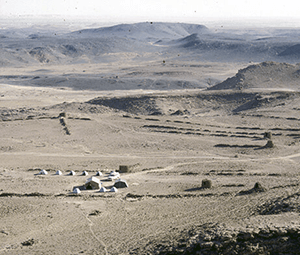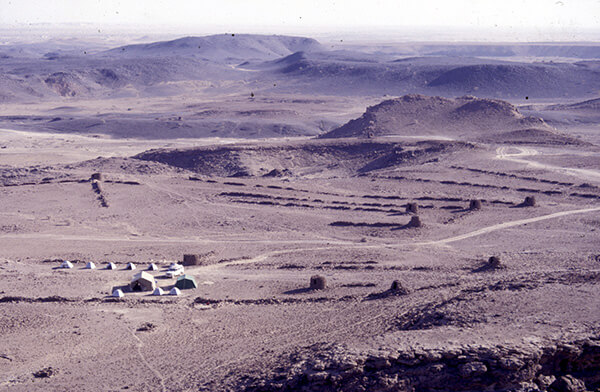
AL-MAḪDARAH
Arabic name
المخدرة
Ancient name
–
Region
Maʾrib Governorate
Coordinates

Italian Mission excavated the ‘turret tombs’ in 1986.
Between 1985 and 1987 the Italian Mission dedicated most of its time and energy to a series of investigations and excavations of South Arabian necropolises. The only necropolis known previously was the one excavated by the Americans at Tamnaʿ in the early 1950s. No work had been done concerning tombs in the North, even though there were plenty of them and, given the great variety of types, they appeared most intriguing. In particular, during our explorations in the Khawlān, we had often observed truncated cone turrets in stone, built on the high ground, well away from the settlements. They had been recorded by previous travellers, but there was no indication as to their function. On the site of Al-Makhdarah, not far from Sirwāh (Fig. 1), we found a dense concentration of these turrets, and decided to excavate a dozen of them.
They did in fact prove to be tombs. Although almost all of them had been pillaged in ancient times, our excavations enabled us to establish some of the main features of the funerary rites. The multiple burials suggested that the turrets were family tombs. The last corpses to be deposed conserved various remnants of materials and vegetable matter which probably indicated a crude form of embalming. In general, very few traces remained of the grave goods (just some beads and fragments of bronze and iron). In only one case did we find a complete parure for a young woman, comprising a necklace featuring semi-precious stones, seashells and gold, a carnelian bracelet, a bone ring and objects used in the preparation and implementation of bistre. The absence of ceramic ware was truly striking. Samples of bone subjected to carbon 14 dating proved to date from between the 8th century BC and the 1st century AD. This period was in fact the age in which the Southern Arabian states attained their greatest prosperity.
A systematic study of the distribution of these turret tombs on the territory of the Yemen showed that the necropolises were always situated away from the great fortified cities of the South Arabian period. The tombs can even be located at a distance of over 100 km from the nearest Sabaean or Minaean centre. In some places there were a vast number of tombs: along the northern edge of the Ramlat Sabʿatayn, for example, with the help of aerial photographs we counted more than 4,000. Their distribution was striking, forming long chains covering the ground between the various settlements from the classic era. This suggested that these funerary monuments had been erected along the roads joining one centre and another, which might imply a link between these structures and trading in ancient times.

Countries
